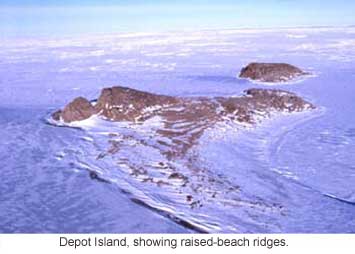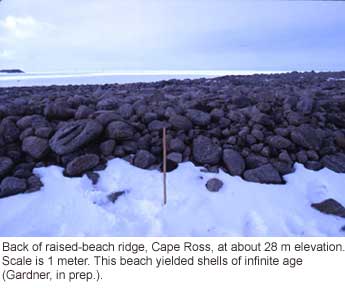Skip navigational links Deglaciation of the Northern Scott Coast, Antarctica
Principal Investigator - Brenda Hall
Graduate Student - Nathan Gardner
Undergraduate Students - Peter Marcotte, Alex Roy, Colby Smith
Other Collaborators - Carlo Baroni, University of Pisa
 Supported by the Office of Polar Programs, National Science Foundation
Supported by the Office of Polar Programs, National Science Foundation
The stability of the marine-based West Antarctic Ice Sheet (WAIS) remains one of the key problems in glaciological and global change research. If the ice sheet were to collapse, global sea level would rise 5-6 m, causing massive coastal erosion and inundation. One way in which to gain insight into future WAIS behavior is to examine its past. During the last glacial maximum (LGM), the ice sheet spread out onto the floor of the Ross Sea, extending to the shelf edge in some places. A chronology of retreat from this LGM position can be used to isolate the mechanism, such as rising sea level, that drove ice recession in the past and which may still be controlling WAIS grounding lines today.

Our approach to reconstructing ice retreat in the Ross Sea Embayment is to develop a series of points along a north-south transect at which we know the timing of ice recession. At present, there are three points - the southern Scott Coast, Hatherton Glacier, and Roosevelt Island. These results were published in Science in 1998. Our present study focuses on the timing of ice retreat past the northern Scott Coast, located roughly between Granite Harbor and Terra Nova Bay. Field work began in the 2000/2001 season at Cape Ross and Inexpressible Island. Additional work will be carried out this year in conjunction with Dr. Baroni.
Our objectives are to map the distribution of raised beaches along the coast. We are also interested in examining beach formation. Dates of individual beaches will be used to construct relative sea-level curves with which to constrain the timing of ice recession. Our initial results indicate that the situation along the coast is much more complex than originally thought. Some beach sediments predate the last glaciation. Young beaches may be superimposed upon old ones.
 Supported by the Office of Polar Programs, National Science Foundation
Supported by the Office of Polar Programs, National Science Foundation



